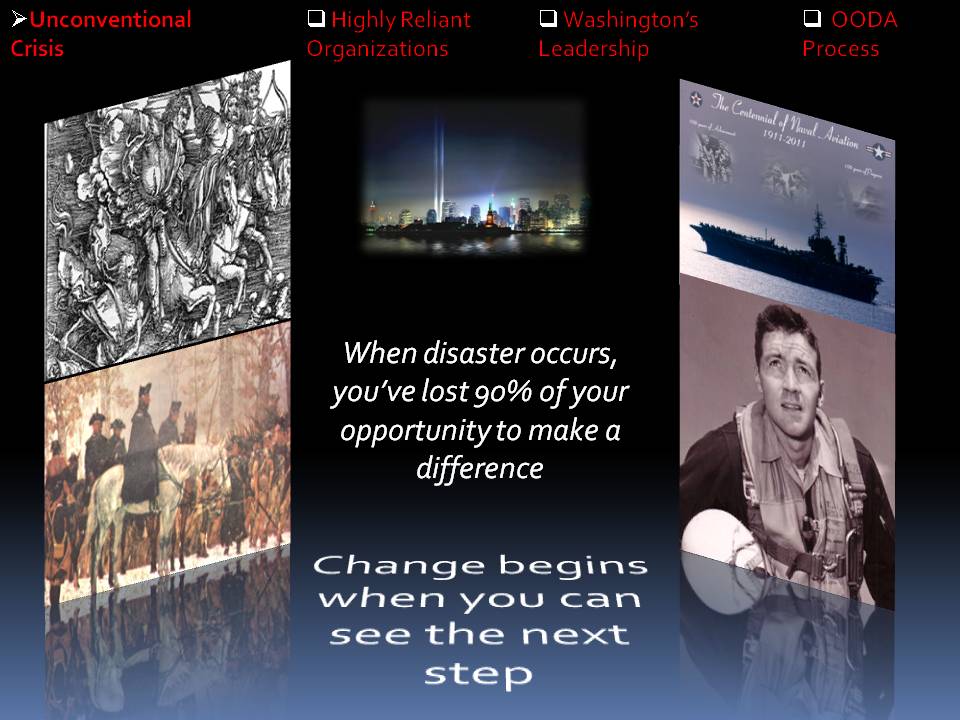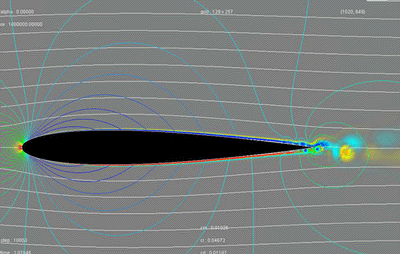Jan.25.2011
7:07 pm
by Ed Beakley
Stall, Spin, Crash, Burn and Die
Boundary Conditions for 2011
Ventura County Fire Department, Battalion Chief Ranger Dorn commenting on Deepwater Horizon
As a result of working around emergency plans and training on Threat, Risk and Vulnerability Assessments around the country and having responded to many significant events, I believe most plans for handling emergencies are based on assumptions and guesses made by well meaning workers/managers and oft times- “experts” – BUT a number have been off base, or completely wrong. . I have heard many proposed solutions from “experts.” Many are easily discounted even though they receive much press”.
You can’t fix things without some understanding, real understanding of the problem – nor can there be real leadership without actionable understanding. That’s where establishing boundary conditions as a vehicle to frame the problem – and therefore garner greater insight – become important.
With the concept introduced previously of intersections from seemingly disconnected fields in mind, I have determined to explore the usefulness of the UC concept in discussion of decision making in severe crisis by addressing it in context as one of four research boundary conditions to be presented via this FORUM/Blog. The four previous posts (links provided) have provided introductory remarks defining those boundary conditions and are summarized below.
1) Unconventional Crisis; 2) Carrier Aviation as a High Reliability Organization; 3) Washington’s Leadership; 4) John Boyd’s Way

Boundary conditions – the set of conditions specified for the behavior of the solution to a set of differential equations at the boundary of its domain – are important in determining the mathematical solutions to many physical problems. More specifically, concerning flight, the condition is noted as the boundary layer – the layer of reduced velocity in fluids, such as air and water, that is immediately adjacent to the surface of a solid – the wing – past which the fluid is flowing. If the angle of incidence of an airfoil in relation to airflow is increased, whether initiated by the pilot or by impact of turbulent air, the boundary layer flow can slow to the point of turbulence ( loss of laminar flow) and in this disruption, the flowing air can no longer stay attached to the layer/airfoil, drag over comes lift and the wing is no longer in stable positive flight – not flying it stalls – etc., etc., etc – the title applies!

Drilling for oil at a depth of 5000ft and in open ocean – Deepwater Horizon – should have been/should be seen as a “crisis” in waiting no matter the historical track record. Proper understanding would have meant that the National decision making level immediately recognized the high potential for the initial crisis migrating into a severely complex catastrophe after the explosion and acted, not waiting to see if BP’s response plans would work. Activities in “Blue Water”/open ocean are not a linear extrapolation from “inshore,” nor is 5000 ft a linear extrapolation from 200ft or 500ft. depths. BP’s plans might have been up to the problem, but the shear nature of the environment, if scrutinized in context of “unconventional” as described below, should have been a trigger to initiate intermediate action. Rather, the declaration of an Event of National Significance was 30+ days in coming??? A significant point, I believe, is the problem generated by not recognizing the nature or even acknowledging the existence of a different kind of problem, one potentially very complex or stochastic in nature – an “unconventional crisis.”
The idea of unconventional crises was first introduced in 2007 by Dr. Erwan Lagadec in Unconventional Crises, Unconventional Responses: Reforming Leadership in the Age of Catastrophic Crises and Hypercomplexity. As defined, these events are distinguished from more familiar or routine emergencies and conventional disasters by the presence of significantly new circumstances and different kinds of intellectual challenges. The main characteristic of unconventional incidents is that they are exceedingly difficult to map. This can be due to:
> the technical complexity of response efforts
> an unusually complex geography of affected areas
> the potential for a crisis suddenly to affect systems and interests that initially seemed remote
> a bewildering kaleidoscope of stakeholders
> confusing, overwhelming, or, conversely, insufficient information
With a high degree of difficulty in “mapping” the operational environment, we now require decision making under circumstance with hyper complex characteristics.
Along with this and stated many times on this website, low probability, worst case disasters – the CAT 5’s – require a different mindset – not only for operations, but for education, training, and planning. It is most certain that responding organizations will require thinking and planning (learning required) that differentiates between preparedness and readiness; they will require the ability to operate and adapt in a high tempo Observe-Orient-Decide – Act manner; and they will require leadership that transcends normal political, operational, and functional boundaries.
The PWH main theme remains decision making in severe crisis as a distinct skill required for community resilience and survivability on our own terms and since inception, the path for Project White Horse has evolved as follows:
- Bounding the problems of severe crisis/disaster – the Cat 5s – as distinctly unique
- Discussions on decision making Such as Dr. Gary Klein’s Recognition Primed Decision Making (RPDM)and John Boyd’s Discourse on Winning and Losing
- Teams of Leaders
- Resilient Communities ideas
- General Russ Honore’s Culture of Preparedness
- The 2010 question “what kind of organizations (and groups of organizations) can operate at the necessary OODA tempo to survive and indeed thrive through unconventional, hyper complex crisis events?”
Even though the main PWH website content currently centered on a “Culture of Preparedness,” has not changed throughout 2010, research and FORUM/Blog publication has continued to address the underlying operational thread and question: What kind of a community or organization –or indeed, group of organizations – can survive and thrive in uncertain and severe crisis environments? Increasingly it became apparent that the concept of unconventional crisis (UC) offered a critical and indeed necessary perspective. So, in work and soon to be online, the main PWH website will provide a greater level of depth on unconventional crisis and introduce related topics. And as always, the intent for the FORUM and INTERSECTIONS elements of PWH will be to provide discussions on various aspects of that operational thread, as a meaningful path for greater insight on the core ideas. As noted above, the Blog will be used to provide discussion leveraging four boundary conditions as follows:
- Unconventional crisis (2010: The Earth Strikes Back) as introduced above.
- Naval Aviation throughout its 100 years particularly as the airwing and carrier represent a highly reliant organization with flight operations at sea the closest to the “edge of the envelope” day-day execution of mission under the most extreme conditions in the least stable environment, and with the greatest tension between preserving safety and reliability while attaining maximum operational efficiency (Ghosts of Christmas Past: Fly Navy 100 Years)
- Washington’s leadership in holding the Continental Army together particularly through the winter of of 1776 and 1777. In today’s terminology he fought a hybrid style of warfare – on occasion as European Armies fought, on occasion pure guerrilla warfare. Francis Marrion’s actions in South Carolina are obvious, but his leveraging of the hit and run harassing tactics of the New Jersey militias that wore down the Hessian Forces considerably prior to the Battle of Trenton are not so well known or even acknowledged. Hessian forces defended in good order – not drunk or hung over – but it was Washington’s leadership and sheer audacity in the face of incredibly bad weather conditions that made all the difference. (Christmas 1776: The Crossing)
- The OODA way of thinking as an analysis tool for all in light of Col John Boyd’s work – Patterns of Conflict, Destruction and Creation, Essence of Winning and Losing (the real OODA process). Discussed previously in light of the decision path, but expanding into the need to introduce novelty, insight, initiative, adaptability and harmony so as to improve fitness for survival. (Searching For John Boyd)
While this may appear a strange mix, initial thinking along this line reveals that this approach will provide a vehicle(s) to introduce disscussions of concepts such as relative superiority from Admiral William McRaven’s SPECOPS, rapid reflection forcesfrom Lagadec, systemic operational design from the Army’s Advanced School of Military Studies, and allow expansion of previously introduced ideas such as preparedness vs. readiness by Von Lubitz, highly reliant operations from LaPorte, Commander Leader Teams fom Bradford and Brown, and organizational response from Roux-Dufort. And last but certainly not least, this boundary conditions approach will provide a significant methodology for leveraging the work of John Boyd beyond warfare and business to the distincly different context of leadership and decision making for unconventional crisis response. Hopefully the relevance of each in relation to the others and the main theme will be come more apparent throughout the year. We bound the problem so as to better understand our situation within our environment. Without that understanding we run high risk of stall, spin, crash, burn, and die when encountering the hyper complex, the unconventional.
I do not know what the research, reading, thinking, or dialogue may yet produce. The journey should be fun though.
JEB
Filed in 2011 Boundary Conditions | Comments Off on Stall, Spin, Crash, Burn and Die
